Kurukshetra Summary: June 2025 | Current Affairs & Hindu Analysis: Daily, Weekly & Monthly - UPSC PDF Download
| Table of contents |

|
| Cooperatives and Food Security |

|
| Strengthening the Cooperative Sector in India |

|
| Crop Residue Burning in India |

|
| Cooperatives: Key to Inclusive Rural Growth |

|
Cooperatives and Food Security
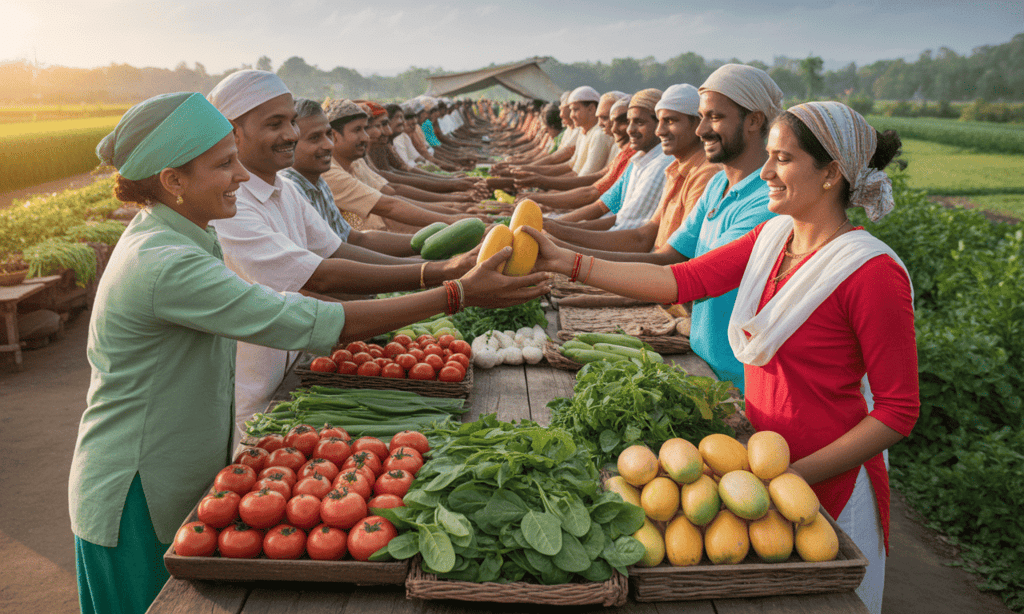 Cooperatives' Impact
Cooperatives' Impact
- Food security is crucial for a nation's progress, as it is closely tied to lowering poverty, improving nutrition, and aiding rural communities.
- According to the FAO, food security means having enough safe and nutritious food available physically, socially, and economically.
- Food security is an important part of the Sustainable Development Goals, especially SDG 2, which aims for Zero Hunger.
- In India, food security is challenged by factors like low agricultural productivity, inadequate post-harvest storage, supply chain problems, and high food waste.
- Cooperatives, particularly Primary Agricultural Credit Societies (PACS), play a vital role in storing and purchasing food grains.
- This role has become more important since the 2023 launch of the World’s Largest Grain Storage Plan in the Cooperative Sector, which aims to enhance storage facilities and reduce food waste.
The Storage Paradox: High Output, Low Capacity
 Storage Crisis
Storage Crisis
- India is a leading producer of food grains worldwide.
- However, there is a significant problem with insufficient storage facilities, which affects food security and the income of farmers.
- Global Cultivable Land Share: India has 11% of the world's cultivable land, totaling 16 crore hectares out of 138 crore hectares.
- Global Population Share: India makes up 18% of the global population, approximately 140 crore out of 790 crore people.
- Total Food Grain Production in 2021: India produced 311 million metric tonnes (MMT) of food grains.
- Current Storage Capacity: The existing storage capacity is only 145 MMT.
- Storage Shortfall: There is a storage shortfall of 166 MMT.
- Storage Gap Percentage: India experiences a storage gap of 47%, indicating a substantial difference compared to self-sufficient countries.
- Post-Harvest Losses: Each year, 10-15% of food grains are lost after harvesting.
- Economic Losses: The annual economic loss is estimated at around ₹90,000 crore (Gulati et al., 2024).
- The mismatch between food grain production and storage results in:
- Panic selling by farmers.
- Wastage of food grains.
- Farmers receiving lower prices for their produce.
- Increased pressure on the Food Corporation of India (FCI), whose storage facilities are often overloaded.
- Deterioration in grain quality and rising carrying costs.
Overview of the World’s Largest Grain Storage Plan (2023)
 Grain Storage Initiative
Grain Storage Initiative
- Objective: The Government of India has initiated the World’s Largest Grain Storage Plan in the Cooperative Sector to address storage shortages and reduce food waste.
- Launched by: The plan was introduced by the Ministry of Cooperation on May 31, 2023.
- Proposed Investment: The government plans to invest ₹1.25 lakh crore in this initiative.
- Storage Capacity Target: The aim is to achieve a storage capacity of 70 million tonnes (MMT) within 5 years.
- Implementation Partner: The plan will be implemented with the support of 67,000 functional Primary Agricultural Credit Societies (PACS) across India.
Progress as of 2025:
- Godowns have been built in 11 PACS across 11 states.
- Foundation stones have been laid for 500 PACS.
- Construction has started in 576 PACS.
- The computerisation of PACS has been completed in 67,930 PACS.
- There are 43,658 operational PACS at present.
- The project focuses on creating local godowns, allowing farmers to store their produce nearby. This approach helps lower transport costs, minimize post-harvest losses, and improve community food security.
The Role and Potential of PACS
- PACS (Primary Agricultural Credit Societies) are local organizations within India’s cooperative credit system.
- They play a crucial role in supporting rural farmers by providing essential services.
- PACS offer loans, necessary supplies, buying services, and storage options to farmers.
Influence of PACS on Food Security
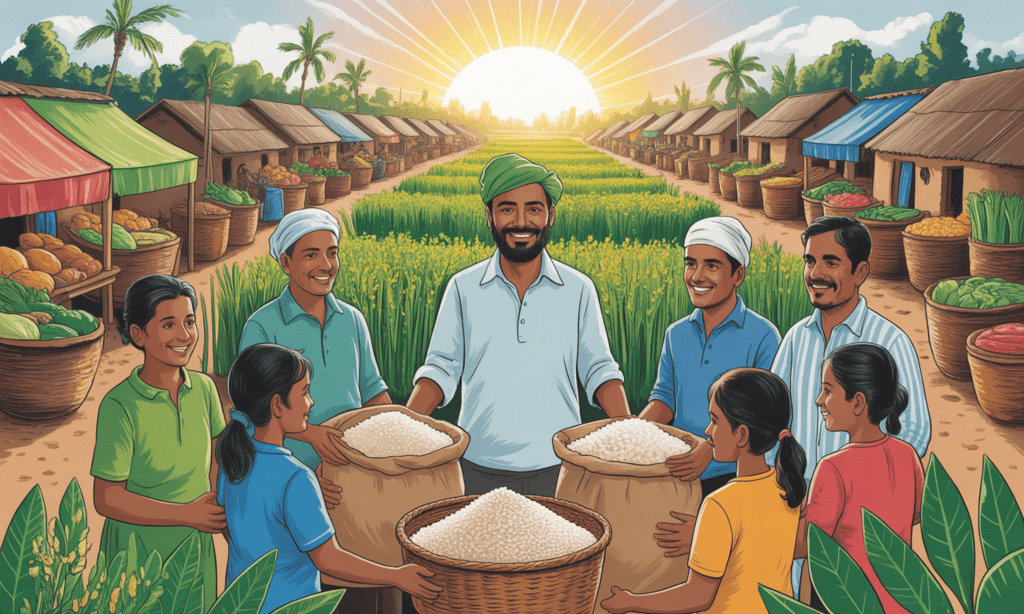 PACS Impact on Food Security
PACS Impact on Food Security
- India is home to more than 110,000 Primary Agricultural Credit Societies (PACS).
- These PACS have approximately 130 million farmer members.
Ways in Which PACS Strengthen Food Security:
- Directly purchasing grains at the Minimum Support Price (MSP).
- Providing agricultural inputs and advisory services to farmers.
- Establishing local grain storage solutions to lessen dependence on the Food Corporation of India (FCI).
- Empowering small and marginal farmers with price security measures.
- Facilitating online trading through platforms like e-NAM.
Examples of Successful Cooperatives:
- Tamil Nadu: Cooperatives manage 94% of Fair Price Shops in the state.
- Amul: This cooperative model has revolutionized India’s dairy industry.
- Mother Dairy: Provides milk and vegetables at consistent prices.
- Maharashtra Grain Banks: Implements a loan-in-grain system to support tribal regions.
- NAFED: Responsible for maintaining national reserves of essential items like pulses and onions.
Convergence with Government Schemes
 Grain Storage Initiative
Grain Storage Initiative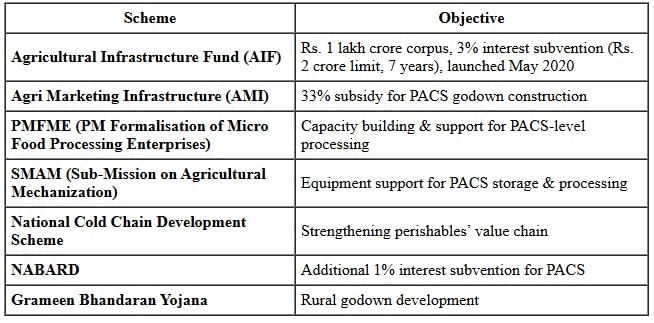
The grain storage initiative is supported by a combination of various Government of India (GoI) schemes, ensuring effective resource utilization and cooperation among institutions.
Challenges in Implementation
- Coordination Between Agencies: There are delays and overlapping responsibilities among cooperative societies, state departments, and financial institutions.
- Availability of Land: In densely populated rural areas, it is necessary to work with local Panchayats to consolidate land for storage facilities.
- Timely Distribution of Funds: Quick access to funds is crucial to prevent delays in project implementation.
- Capacity of PACS: Before granting funds, it is important to assess the capacity and capability of Primary Agricultural Cooperative Societies (PACS).
- Lack of Trained Staff: There is a shortage of skilled personnel necessary for managing inventories and ensuring quality control in storage facilities.
- Risks in Management: There are opportunities to enhance transparency, accountability, and sustainability in the management of storage operations.
Governance and Monitoring Mechanism
- National Level: An Inter-Ministerial Committee (IMC) has been set up for overall strategic management of the grain storage initiative.
- State Level: State Cooperative Development Committees are responsible for managing cooperative issues and overseeing the implementation of the initiative at the state level.
- District Level: District Cooperative Development Committees address cooperative matters and monitor the progress of the initiative at the district level.
Digital Dashboard Monitoring:
- Computerization of PACS enables real-time tracking and monitoring of storage facilities and inventory levels.
- The integration of Artificial Intelligence (AI) technology assists in inventory management, purchase analysis, and improving operational efficiency.
- e-NAM (Electronic National Agriculture Market) facilitates clear and direct trading, enhancing transparency and efficiency in the marketing of agricultural produce.
Capacity Building & Awareness Generation
- Training Needs:
- Digital literacy: Training programs to enhance digital literacy among PACS staff and farmers, enabling them to use technology effectively for storage and inventory management.
- Inventory control: Providing training on inventory control techniques, including tracking stock levels, managing expiry dates, and ensuring proper rotation of stored goods.
- Storage techniques: Educating PACS staff and farmers about best practices for storage, including pest management, temperature control, and moisture regulation to maintain the quality of stored grains.
- Regulatory compliance: Training on the legal and regulatory requirements related to grain storage, including safety standards, quality control measures, and reporting obligations.
- Awareness Campaigns:
- Conducting awareness campaigns to inform farmers about the services offered by PACS, including storage options, quality assurance, and price stability.
- Building trust in warehouses operated by PACS through community engagement, showcasing success stories, and highlighting the benefits of using PACS for storage and marketing.
Impact on Food Security
- Food security involves maintaining buffer stocks and ensuring effective public distribution of food grains.
- The grain storage programme enhances food security by improving storage facilities at the local level, reducing waste, and ensuring better quality of grains.
- It also helps in providing better prices and stable income for farmers, contributing to their economic stability.
- The programme aligns with various government initiatives such as PM-KISAN (Pradhan Mantri Kisan Samman Nidhi) for providing income support to farmers, PMFBY (Pradhan Mantri Fasal Bima Yojana) for crop insurance, and e-NAM (Electronic National Agriculture Market) for ensuring transparent pricing and marketing of agricultural produce.
Contribution to Sustainable Development Goals (SDGs)
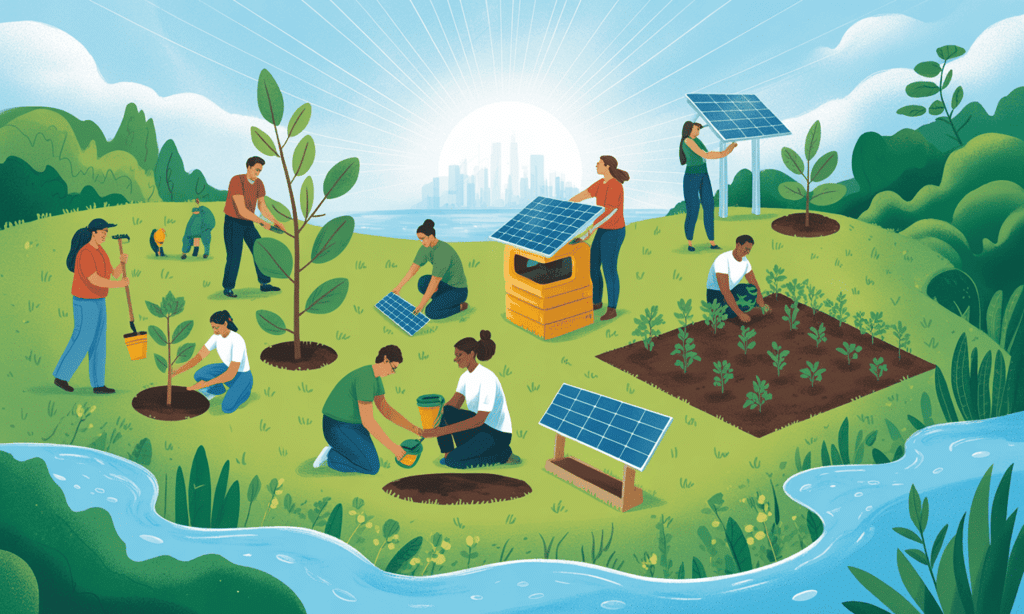 Grain Storage Initiative
Grain Storage Initiative
Conclusion
- The World's Largest Grain Storage Plan, implemented through PACS, marks a significant step forward for India's food security strategy.
- This initiative aims to decentralize storage to improve accessibility.
- The plan seeks to empower cooperatives, allowing local groups to manage their own storage facilities.
- It utilizes digital tools to enhance efficiency and effectiveness in storage management.
- Successful implementation depends on timely funding and collaboration among various agencies.
- Access to land is essential for establishing storage facilities.
- Capacity building is crucial to equip local communities with the skills needed for effective storage management.
- This initiative aligns with the vision of “Sahkar se Samriddhi”—prosperity through cooperation.
- The model is designed to be sustainable and easily replicable in other regions.
- It provides a strong framework for post-harvest management and supports rural development.
Strengthening the Cooperative Sector in India
 Cooperative Strengthening
Cooperative Strengthening
- The cooperative sector in India is essential for the rural economy, consisting of over 850,000 societies with approximately 290 million members.
- These cooperatives are involved in various sectors, including dairy, fisheries, housing, marketing, and agriculture.
- To meet market demands and prioritize their members' needs, skill development within cooperatives is crucial.
- Improving skills in cooperatives enhances their competitiveness, resilience, and independence.
Importance of Skilling for Cooperatives
 Skilling Cooperatives
Skilling Cooperatives
Skilling is essential for the sustainability and growth of cooperatives in today's competitive environment.
- Cooperatives are member-owned businesses with two primary objectives: safeguarding member interests and achieving financial success.
- They bring together small producers, traditional skills, and local services, necessitating a diverse range of skills, including:
- Entrepreneurial skills
- Management capabilities
- Governance knowledge
- Technical expertise
To support these needs, India has implemented various skill development policies, such as:
- PMKVY (Pradhan Mantri Kaushal Vikas Yojana)
- SANKALP (Skill Acquisition and Knowledge Awareness for Livelihood Promotion)
- STRIVE (Skill Training for Industrial Value Enhancement)
- Skill India Mission
The 2025 Budget announced the creation of five National Centres of Excellence for Skilling, highlighting the government's commitment to skill development.
Global Context and Insights from the International Cooperative Alliance (ICA)
 Cooperatives and Employment
Cooperatives and Employment
- Cooperatives are a significant source of employment worldwide, providing jobs to 280 million people, which accounts for about 10% of the global workforce and over 12% of the population.
- The International Labour Organization (ILO) reports that more than 50% of agricultural products globally are sold through cooperatives.
- The ILO's Recommendation 193 promotes education and training in cooperatives, emphasizing their importance in sustainable development. Resources like OUR.COOP packages are highlighted for their role in this process.
- The International Cooperative Alliance (ICA) and its regional branches, such as ICA-AP, are dedicated to supporting the establishment of new cooperatives, conducting research, and setting educational standards.
- Addressing global challenges such as skill mismatches, digital illiteracy, and ineffective governance is crucial and requires urgent attention.
Institutional Innovation: Sahkari University (Tribhuvan University Act, 2025)
 Cooperative University
Cooperative University
- The Tribhuvan Sahkari University Act, 2025, establishes India's first national cooperative university, taking over from the Institute of Rural Management Anand (IRMA).
- This university is designed to offer multidisciplinary education, cultivate skilled professionals, and promote grassroots entrepreneurship .
- In line with the National Education Policy (NEP) 2020, the university aims to:
- Bridge the gaps in training .
- Facilitate the digital transformation of education.
- Establish global benchmarks in cooperative education .
- Additionally, the university plans to support the digital transformation of education and set international standards in cooperative education.
Challenges and Opportunities in Building a Resilient Cooperative Sector
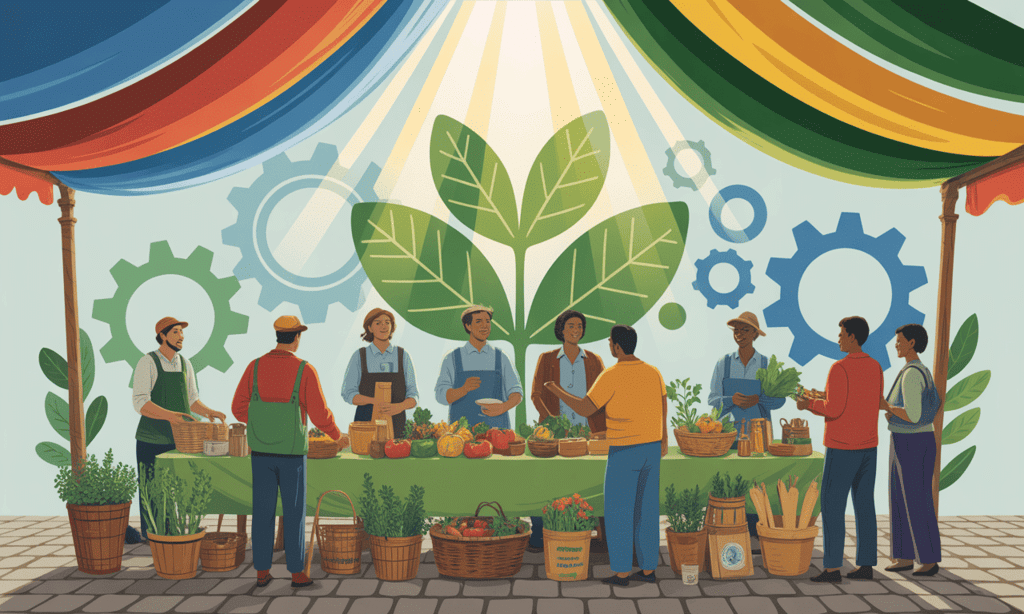 Cooperative Development
Cooperative Development
Challenges
- Fragmented Skilling Infrastructure: The cooperative training system in India is disjointed, lacking consistency, quality checks, and coordination. Current education does not adequately cover essential skills in entrepreneurship, governance, or digital technology.
- Low Youth Participation & Succession Gaps: The limited engagement of young people in cooperatives hampers leadership renewal and innovation. There are no formal succession plans, risking sustainable management.
- Skill Mismatch & Informal Workforce: The India Employment Report 2023 highlights that many low-skilled workers are in sectors like trade, transport, storage, and education.. disconnect exists between the traditional skills of cooperative members and market demands, hindering productivity.
- Digital Backwardness: Most cooperatives lack necessary digital infrastructure and trained personnel. This deficiency prevents them from using e-platforms (e.g., e-NAM), adopting AI tools, and engaging in formal markets.
- Weak Governance & Transparency: Problems such as political interference, inadequate financial management, and low member awareness adversely affect accountability and performance, causing many cooperatives to become inactive or face financial challenges.
Opportunities
- Policy Convergence and Skilling Ecosystem: Initiatives like PMKVY, STRIVE, SANKALP, NAPS, NSDM, and PM-YUVA can be tailored to meet the specific requirements of cooperatives, focusing on governance, supply chains, financial literacy, and entrepreneurship.
- Digital Transformation Initiatives: By 2025, the computerisation of 67,930 Primary Agricultural Credit Societies (PACS) will be complete; digital dashboards will improve transparency. The adoption of AI, online procurement systems (e-NAM), and smart monitoring tools will enhance competitiveness.
- Institutional Innovations: Key reforms such as Sahkari University (Tribhuvan University Bill 2025), NCEL, NCOL, BBSSL, and M-PACS aim to upgrade education, prepare for export, standardise practices, and drive innovation in agricultural cooperatives.
- Youth & Women Empowerment via Cooperatives: There are 8.5 lakh cooperatives with 29 crore members, many from disadvantaged backgrounds. Targeted skills programmes and incubation initiatives can boost cooperative entrepreneurship in areas like dairy, crafts, and processing.
- Multistakeholder & Global Backing: Support is provided by organisations such as ICA, ILO, COPAC, MoC, NABARD, and NEP 2020. ICA: About 12% of the global population is involved in cooperatives, creating 280 million jobs and generating a turnover of $2409 billion among the top 300 cooperatives.
- A global movement is emerging to create skill-based, environmentally friendly, and inclusive cooperatives, aligned with the IYC 2025 and SDG framework.
Way Forward
- Encourage continuous learning and adapt skills to job market needs.
- Enhance collaboration between national and state governments, as cooperatives are under state jurisdiction.
- Utilise online platforms, artificial intelligence, and data-driven management in cooperative organisations.
- Support the establishment of cooperative businesses among youth and women.
- Provide consistent and recognised skill frameworks tailored for cooperative activities.
- Skilling is not merely a technical process; it is a strategic tool for building a robust, competitive, and inclusive cooperative sector.
- The launch of India’s first cooperative university and the renewed focus on the policy termed “Sahkar se Samriddhi” present a significant opportunity for transformation.
- With appropriate policy alignment, institutional support, and capacity building, India has the potential to lead in the global cooperative movement.
- This movement aims to promote sustainable development and empower rural communities.
Crop Residue Burning in India
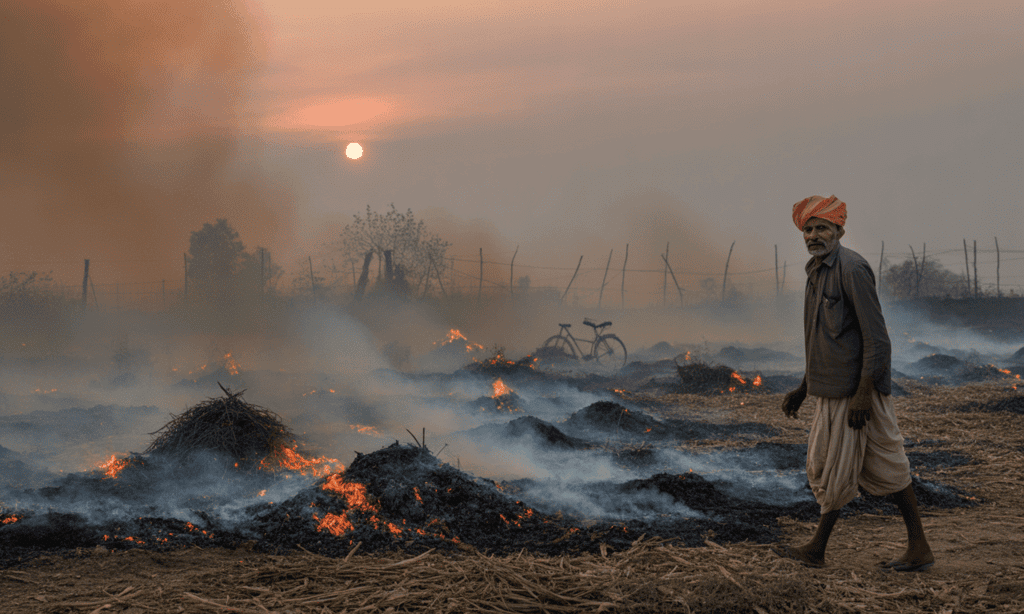 Crop Burning Practices
Crop Burning Practices
Background and Emergence
- Crop residue burning became common in India after 1986, following the adoption of mechanized harvesting. This method left behind stubble that cannot be reused without manual cleanup.
- Seasonal trends in burninginclude:
- Rice stubble is typically burned in October and November to prepare for wheat planting. Wheat stubble is burned in April and May.
- Sugarcane residue burning varies by region after harvest.
- Initially, crop residue burning was prevalent in Punjab, but it has now spread to Haryana, Uttar Pradesh, and other northern states of India.
- India generates approximately 686 million tonnes of crop residues annually, with cereals contributing 368 million tonnes. rice alone accounts for 34% of this total.
Challenges Posed by Residue Burning
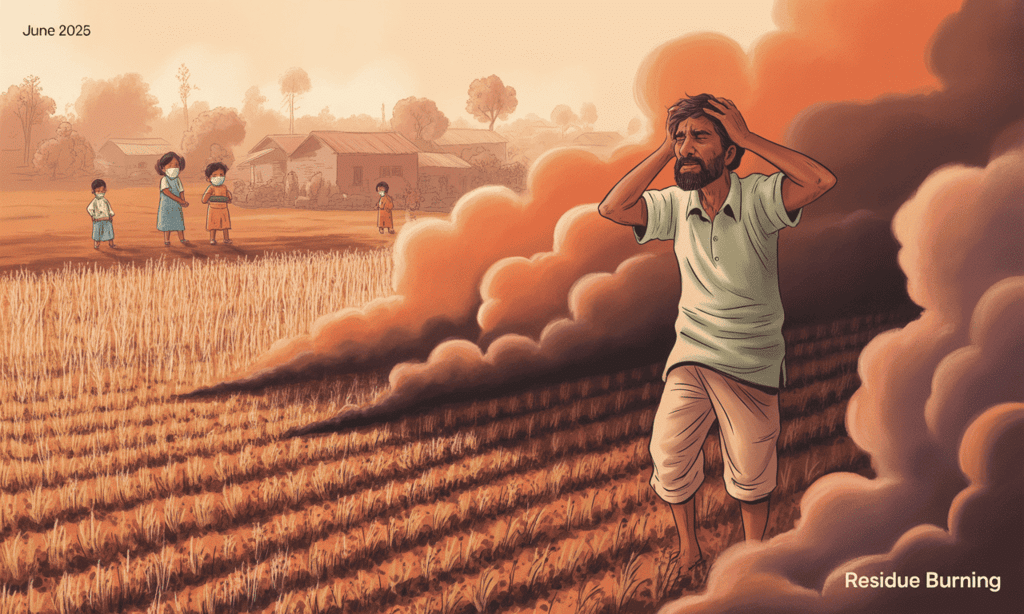 Soil and Air Pollution
Soil and Air Pollution
- Environmental and Soil Health Hazards:
- Residue burning results in the loss of approximately 80% of essential soil nutrients, including nitrogen (N), phosphorus (P), potassium (K), sulfur (S), and organic carbon.
- It also diminishes beneficial soil organisms and reduces the fertility of the topsoil.
- Increased surface temperatures due to burning can disrupt the soil structure.
- Air Pollution and Public Health:
- Burning releases harmful gases such as carbon dioxide (CO₂), methane (CH₄), nitrous oxide (N₂O), nitrogen oxides (NOₓ), and particulate matter like PM2.5 and PM10, which are linked to cancer.
- It significantly contributes to toxic smog in the Delhi-NCR region, particularly during winter months.
- This practice is a major factor in respiratory issues and other health problems.
- Greenhouse Gas Emissions:
- Burning rice straw emits about 70% of its carbon as carbon dioxide (CO₂), 7% as carbon monoxide (CO), and 0.66% as methane (CH₄); it also releases around 2.09% of nitrogen as nitrous oxide (N₂O). These gases are potent contributors to greenhouse effects.
Reasons Why Farmers Persist in Burning Crop Residue
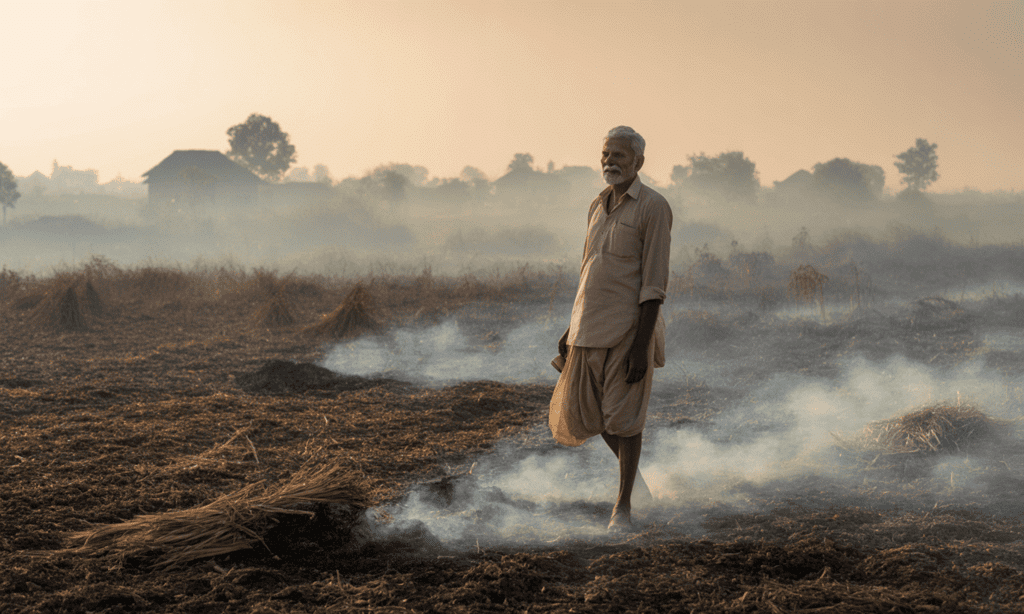 Crop Residue Burning
Crop Residue Burning
- Limited timeframes for planting new crops within the rice-wheat cultivation system.
- High costs associated with manual removal and alternative technologies pose a significant barrier.
- Lack of awareness and poor adoption of environmentally friendly practices.
- Inadequate infrastructure for the collection, storage, and processing of crop residue.
- Insufficient incentives or subsidies for small and marginal farmers.
- Weak enforcement of regulations prohibiting burning.
Sustainable Crop Residue Management (CRM) Options
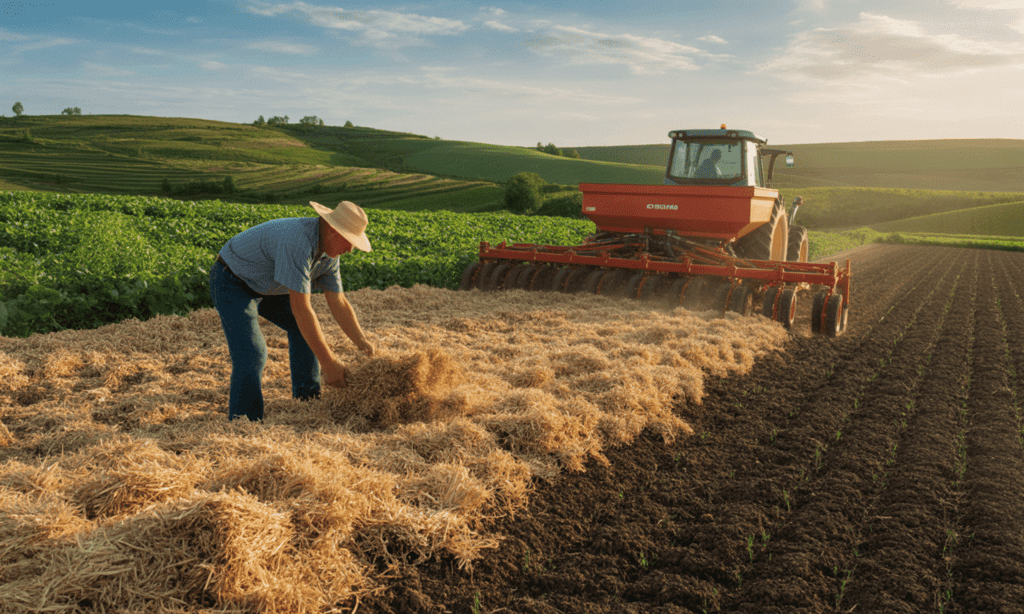 Sustainable Farming Practices
Sustainable Farming Practices
- In-situ Management.
- Use of machines like Happy Seeder, Super Seeder, and Rotavator for mixing stubble into the soil.
- Mulching helps in keeping the soil moist.
- No-till and strip-till farming methods minimize soil disturbance caused by plant residues.
- Incorporating cover crops and practicing crop rotation naturally enhances soil health.
- Ex-situ Utilisation.
- Biomass power plants convert materials like straw into energy.
- Composting and producing organic manure enrich the soil.
- Biochar helps in capturing carbon and improving soil quality.
- Industries utilize crop residues for making paper, packing materials, and boards.
- Comprehensive crop residue management initiatives are essential for sustainability.
Challenges & Gaps:
- High cost of machinery even with subsidies.
- Limited understanding and use of eco-friendly options.
- Insufficient local infrastructure for collecting, transporting, and processing waste.
- Fodder shortage. National shortfall of 23.4%, reaching 43.5% in western India.
Solutions:
- Financial and Technological Support: Increase financial aid for implementing CRM systems, promote shared ownership and rental options through FPOs, SHGs, and CHCs, and encourage the use of short-duration crop varieties to manage leftovers on time.
- Strengthening Infrastructure: Invest in local collection systems, baling units, and transport methods, while also supporting biomass-based power plants with financial incentives to improve the use of leftover materials.
- Innovative Use of Residues: Promote turning crop leftovers into biofuels like ethanol and biodiesel, and encourage industrial uses such as making cement from rice husk ash, paper from banana peels and sugarcane waste, and growing mushrooms using bagasse ash.
- Fodder Security: Address the shortage of animal feed by moving extra straw from areas with surplus to those with shortages, and compress it into bales for easier transport, storage, and use.
- Environmental Benefits: Enhance soil health by increasing organic carbon content from 0.3% to 0.5%, boosting soil fertility, moisture retention, and long-term climate resilience.
Cooperatives: Key to Inclusive Rural Growth
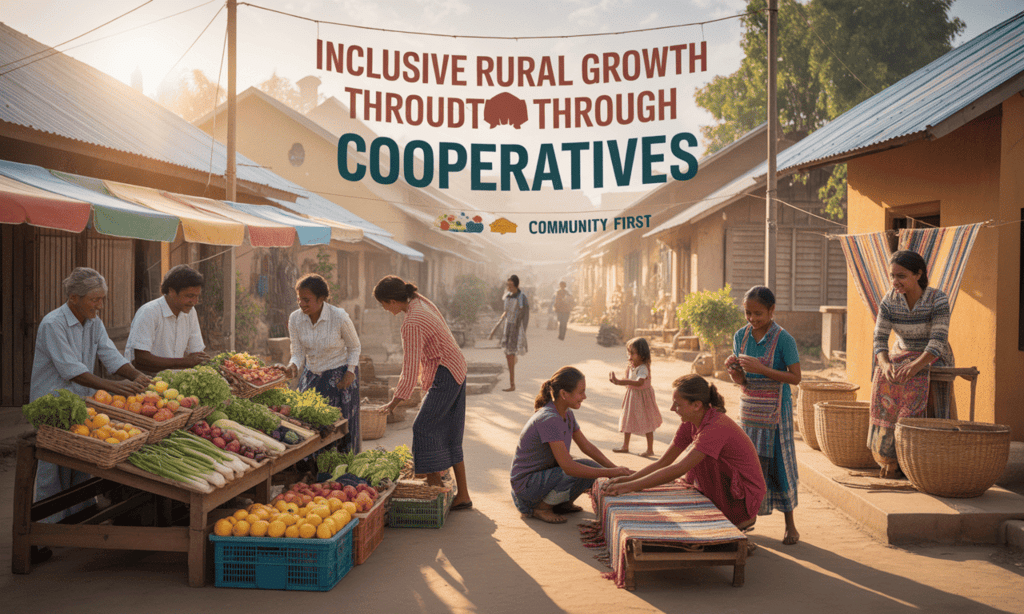 Inclusive Cooperatives
Inclusive Cooperatives
The Indian rural economy, primarily dependent on agriculture, faces serious challenges like low productivity, small land holdings, limited resource access, and poor market connections. Addressing these issues requires a focus on empowerment, participation, and inclusion. Cooperatives and farm collectives, which are integral to Indian society, present an effective model for inclusive and sustainable rural development.
Importance of Cooperatives
- Backbone of Agriculture:. significant portion of India’s rural population is involved in agriculture, although not all are engaged in it full-time. The sector faces challenges such as fragmented land ownership and inadequate resources.
- Strength in Unity: Cooperatives empower farmers by providing better access to loans, supplies, infrastructure, and markets, enhancing their ability to secure fair prices.
- Comprehensive Development: These organizations foster community-led management of natural resources, protect biodiversity, and promote eco-friendly practices for sustainable agriculture.
- Democratic Principles: Cooperatives function on democratic ideals, strengthening social ties, shared responsibilities, and inclusive growth.
Institutional and Policy Support
 Cooperative Revitalization
Cooperative Revitalization
- The conventional top-down approach has proven ineffective due to the absence of farmer-controlled institutions.
- Revitalizing cooperatives is essential for achieving food security, generating employment opportunities, improving climate resilience, and fostering rural prosperity.
- The creation of the Ministry of Cooperation in 2021 reflects the government’s commitment to actively support cooperatives within the national development framework through various initiatives and policies.
Vision for a Cooperative-Driven Rural Economy
 Cooperative Economy
Cooperative Economy
- Village-Level Cooperatives: Establish a cooperative in each village dedicated to agriculture and overseeing various economic activities.
- Higher-Tier Cooperatives: These cooperatives, organized into clusters, offer a range of services including storage, processing, marketing, energy, education, and health.
- Digital Cooperative Network: Ensure the accuracy of data concerning village cooperatives and higher-tier cooperatives.
- Role in Governance: Assign cooperatives the responsibility of implementing food security programs, thereby reducing the financial burden on the government.
Economic and Social Impact of Cooperatives
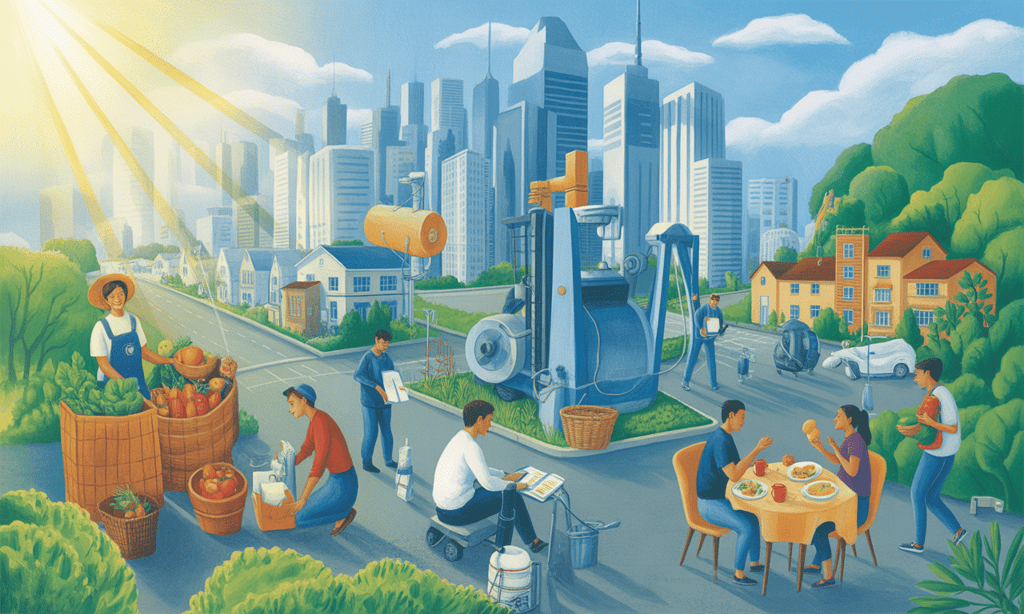 Cooperative Benefits
Cooperative Benefits
- Lower Costs & Reduce Waste: Buying directly from cooperatives helps reduce food waste, ensures fair prices, and lowers production costs.
- Job Creation: Developing local value chains can create job opportunities in rural areas and improve the economic conditions of villages. Providing data, such as statistics or case studies, would strengthen this claim and enhance credibility.
- Stronger Farmers: By collaborating in marketing and services, farmers will gain more power, better options, and improved prices.
- Maintaining Community Peace: Cooperatives foster trust and a shared objective, which are essential for community harmony and resilience.
Challenges and the Way Forward
 Cooperative Empowerment
Cooperative Empowerment
- Reviving Cooperative Conscience: Restore the democratic spirit and accountability in cooperative operations.
- Vertical Integration Needed: Shift from disjointed models to integrated systems that boost collaboration and efficiency.
- Innovative & Responsive Cooperatives: Cooperatives must adjust to market demands and member needs by using new financial strategies and digital tools.
- Unified Institutional Framework: Merge the vast network of around 800,000 agricultural and credit cooperative units into a common digital and management platform.
- Cooperatives are not just businesses; they are tools for collective empowerment, environmental care, and fostering social harmony.
- It is vital to enhance the cooperative model to create a self-reliant, inclusive, and sustainable India.
- As Mahatma Gandhi stated, India 's advancement should originate from its villages, and cooperatives are the best way to facilitate this transformation.
|
38 videos|5167 docs|1089 tests
|
FAQs on Kurukshetra Summary: June 2025 - Current Affairs & Hindu Analysis: Daily, Weekly & Monthly - UPSC
| 1. What are the key benefits of cooperatives in enhancing food security? |  |
| 2. How do cooperatives contribute to building a resilient agricultural sector? |  |
| 3. What role do government policies play in supporting cooperatives for food security? |  |
| 4. In what ways can cooperatives address the challenges of climate change on food security? |  |
| 5. How do cooperatives foster community development and food sovereignty? |  |
















